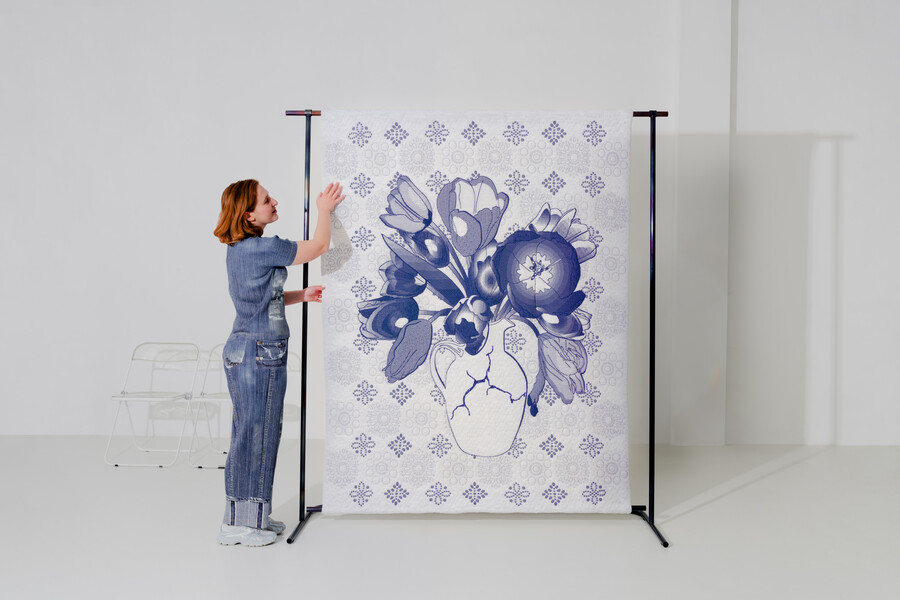After a forced break of two years, designers, producers and design lovers once again flocked to the Salone del Mobile in Milan – this time in June. The TextielMuseum also sent a delegation, which included educator Michelle Baggerman and curator Sjouk Hoitsma. These are the trends and innovations they brought back to Tilburg.
“As a lab and museum, we want to keep abreast of trends; Milan is the best place to see what is happening internationally in textiles,” says Michelle Baggerman. “It’s also really interesting for us to see how stories are told at the fair.” She presented an overview of the trip to all employees, which in 80 slides only scratched the surface of what the Salone had to offer. “It was like the event was playing catch-up after two skipped years,” she says. The lab team was particularly surprised by the big-name brands. While smaller companies are fully focused on sustainability, that aspect was somewhat hidden at the larger companies under an avalanche of luxury products and presentations, in which no effort or expense seemed to have been spared. “Apparently, consumerism is back with a vengeance to make up for the Covid losses.”

A knitted rug by Lola van Praag. Photo: N/J Studio, Naomi Jamie
Lab as the latest trendy word
On the other hand, the delegation was pleasantly surprised to see so many projects from the TextielLab in a new setting. From the weathered fabrics by Aliki van der Kruijs and Jos Klarenbeek to the knitted tapestries by Lola van Praag and the tufted carpets by Lizan Freijsen. “It’s great to see in Milan how, from the lab in Tilburg, we’re making a mark on the development of new textiles,” says curator Sjouk Hoitsma. Also striking was that the word ‘lab’ is increasingly being used, although rarely for a lab that experiments with techniques and where innovative products are actually made. Rather, the term seems to be the latest trendy word, which threatens to undermine its real meaning and value.
Renewed interest in local crafts
A trend to applaud is the renewed interest in traditional crafts, which are being revived through designer collaborations with local artisans. “In the past, people tended to acquire specific knowledge of materials and techniques somewhere and to use this in their own projects back home,” says Hoitsma. “It’s great to see that more attention is now being paid to co-creation, in which local craftspeople play a role in the creative process. Traditional manual weaving and plaiting techniques from Sardinia, Indonesia, South America and Africa are being given new contemporary applications.” Examples include the raffia techniques of the Congolese-European collective Kilubukila and the hand-woven fabrics of the Colombian company Verdi, which are made from a combination of natural fibres and copper by local weavers. A renewed interest in pure, natural materials was visible in numerous places. The whole team was impressed by The House of Lyria, which had created a scenographic presentation of traditionally woven woollen rugs in the atmospheric attic of the old Alcova barracks.
“It’s great to see in Milan how, from the lab in Tilburg, we’re making a mark on the development of new textiles.” – Curator Sjouk Hoitsma
Trompe-l’oeil
Also notable were the trompe-l’oeil shapes and materials that deliberately mislead viewers, or at least surprise them: rocks that are actually fabric, columns made of linen and silk, and an easy chair upholstered in a layer of stone. The growing focus on 3D textures, which increasingly form self-supporting structures, adds an extra dimension to this. All these elements come together in ‘Molten Memories’ by Sarah Roseman, who worked in the TextielLab during her minor, Reframing Textiles, at the Design Academy Eindhoven. In this tactile rug, memories and fantasies from her childhood melt together in a living landscape; from the mountain of pillows she climbed, to the cooling kitchen tiles under her knees and the grass between the patio tiles tickling her toes.
D-House Laboratorio Urbano
A highlight of the five-day tour of Milan was a visit to D-House Laboratorio Urbano – in this case a real lab which last year began researching innovative manufacturing and printing techniques. It is a mecca for designers who want to manipulate, embroider and decorate fabrics. The days of sewing on buttons, beads and sequins may be numbered, as you can now print them directly on the fabric in any desired shape and colour with a 3D printer.
Embroidery has also been given a major update with the Coloreel extension for existing embroidery machines. The technology uses one spool of white thread, which is dyed on demand on the machine in any colour required. “We watched the process with our mouths open; it’s an absolute game-changer,” says Baggerman. Hoitsma adds, “Colour changes are what make embroidery so labour-intensive. Imagine what a machine like that could do for a TextielLab project like ‘Royal Embroidery’. I would be very interested in collaborating with D-House, whose DNA perfectly matches ours.”